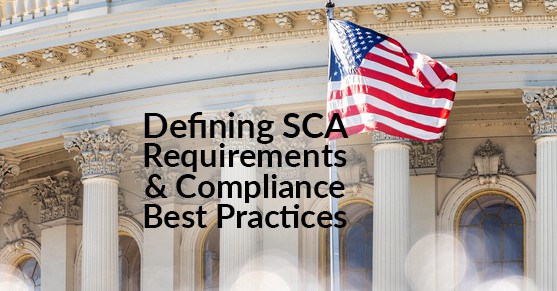Government contracting is one of the most heavily regulated industries in the country; an assortment of laws and acts accompany every single project. An important and frequently misunderstood set of regulations are those laid out by the Service Contract Act (SCA), also known as the Service Contract Labor Standards (SCLS).
As professionals with decades of experience in the government contracting field, experts at GovCon365 have helped numerous organizations navigate SCA regulations. Here are some frequently asked questions that will help you and your organization gain a more comprehensive understanding of the SCA, its rules, and some best practices to avoid violations.
What Is SCA?
The SCA is a federal regulation that sets the standard for the minimum wage that government contractors and their subcontractors are required to pay their employees. The SCA also outlines the requirements for fringe benefits (company vehicles, company cars, subsidized meals, insurance, etc.) offered to employees working on awarded contracts. The primary motive behind the act is to eradicate worker wages as factors in competitive bidding when applying for contracts. Additionally, it also guarantees wages and benefits protection for government contractor employees.
SCA aims to help safeguard both government contractor companies and their employees by offering a level playing field for companies that enter into specific contracts. Determining whether or not the SCA applies to your business is the next topic of our discussion.
When does the SCA apply to your business?
When your firm enters into a contract agreement with any federal agency, government entity, or the District of Columbia, it’s essential to take into consideration the SCA. The contract must exceed the minimum $2,500 and be performed within the U.S. (or its territories) by service employees, and they must be paid the minimum wage provided in section 6(a)(1) of the Fair Labor Standards Act (FLSA). So, for the most part, the necessary contract details are pretty broad, and the SCA applies several projects, but it doesn’t apply to all government contract work.
In general, there are ten types of contracting jobs won’t fall under the jurisdiction of the SCA, which are contracts that include the following:
- Construction, alteration, or repair of public buildings/infrastructure
- Direct services to Federal agencies and departments
- Freight transportation via airplane, bus, truck, express, railway line, or oil/gas pipeline where tariff rates are published and in effect
- Leasing of any space or property
- Services by radio, telephone, or cable companies (under the Communications Act of 1934)
- Public utility services (i.e., electricity, power, gas, water, and steam)
- For postal contract stations operations
- Any services performed outside of the geographical scope
- Projects that are under the jurisdiction of the Walsh-Healey Public Contracts Act (WHPCA)
- Ongoing maintenance of IT and office equipment (including repair, calibration, etc.)
Although those are the primary exemptions from SCA, there are additional exceptions outlined in the Code of Federal Regulations, which can be found here.
What are the repercussions of noncompliance?
Depending on the severity of the violation, failing to comply with SCA regulations can result in a few different scenarios:
- The SCA, as enforced by the Department of Labor (DOL), has the authority to withhold any funds procured through the contract to reimburse underpaid employees.
- The contract can be terminated, dissolving all negotiations and any projected income.
- The contractor can be held liable for costs to the government.
- The SCA can debar the contractor from participating in any contracting bids for up to three years.
In extreme cases, there is the potential for the SCA to exercise all four options, which is why maintaining SCA compliance is a necessary part of government contracting.
A Few Best Practices for SCA Compliance
Always Review Contracts
- We’ve talked about the importance of reviewing proposals in previous blogs, and it’s just as crucial for contracts. Maintaining compliance with any government contracting regulation, be it SCA, DCAA, or DCMA, requires keen observation of contract details and adherence to their contents. By dedicating sincere review and evaluation to every contract will always guarantee smooth project execution, as well as contract fulfillment.
Keep Your Eyes on Fringe Rates
- As government contractors, we know that regulations are anything but stagnant, especially when it comes to wages and fringe rates. We recommend your team consistently review the current state of health/welfare benefits, vacation benefits, and other fringe benefits. By staying on top fringe benefits, you can proactively make changes to your wages and systems to ensure SCA compliance.
Prepare Wage Determinations
- Wage determinations (WDs) outline the minimum wages and benefits regarding job classifications for specific regions under the SCA. For each locality (odd and even-numbered), the DOL issues two standard WDs, which generally have the same designations, wages, fringe benefits, etc. Preparing precise WDs based on geographical location, job classification, and employment status not only provide equality among government contracting employees, but it also safeguards your business against SCA violations. Keeping track of multiple pay rates, seasonal positions, and numerous benefits costs throughout the year is vital.
We hope the information we’ve provided here not only gives your team a better understanding of what the SCA is and how it applies to specific contracts, but also offers a roadmap to compliance. For more information on the SCA, you can find a detailed directory from the DOL here, or you can reach out to one of GovCon365’s many SCA compliance experts.

